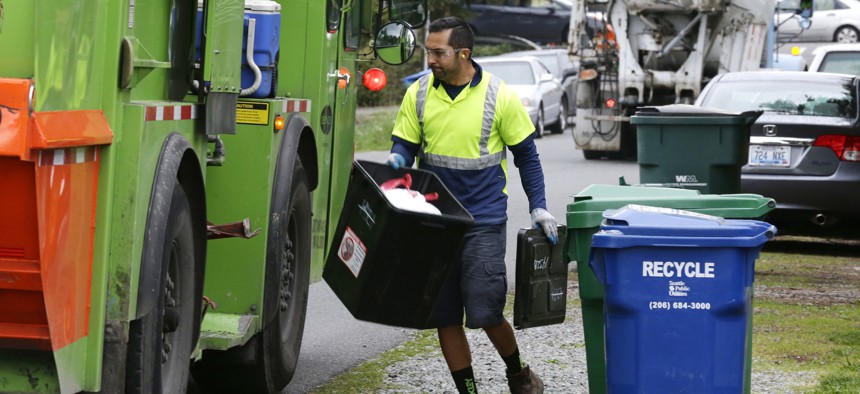EPA Sets National Recycling Goal at 50% by 2030

David Morales, a garbage driver with Recology, picks up a garbage container for Seattle Public Utilities, Friday, April 15, 2016, in Seattle. AP Photo/Ted S. Warren
To increase the national recycling rate from 32% to 50%, the federal government says steps need to be taken to reduce contamination in the recycling stream and strengthen the market for recycled goods.
The Environmental Protection Agency wants 50% of the waste generated in the United States to be recycled by 2030.
Agency officials announced the goal Tuesday during a national recycling summit, detailing strategies they will deploy over next 10 years to increase the national recycling rate from 32%.
“Reaching this goal will not be easy, but it will be important,” said EPA Administrator Andrew Wheeler. “Implementing this goal will require collaboration at all levels of government and across the value chain.”
The national recycling rate is actually headed in the wrong direction, dropping from 35% to 32% from 2017 to 2018, when 94 million of the 292 million tons of municipal solid waste generated that year were recycled and composted. But federal officials said that by creating a broader strategy, they will be able to make it easier for state and local governments that oversee municipal waste collections to run successful recycling programs and to expand markets for recyclable goods.
EPA began to take a particular focus on developing a national recycling strategy to boost recycling rates in 2018, after China stopped accepting most foreign recyclables, including plastics and paper. That move by China has led to higher costs to recycle materials and some local governments have scaled back curbside recycling programs or stopped accepting glass or other materials.
The patchwork of state and local recycling programs, which do not all collect the same types of recyclables, makes it difficult to track national progress on improving recycling rates, said Peter Wright, the EPA’s assistant administrator for the Office of Land and Emergency Management.
But the agency plan focuses on key strategies to increase recycling rates: reducing contamination in recycling collections, making processing systems more efficient, and strengthening the market for recycled materials.
To measure progress in these three areas, Wright said the agency plans to track three key markers: the percentage of contaminants in recycled materials, the percentage of materials that a recycling facility successfully recycles, and the average price of a ton of recycled materials on the market.
“We need definitions and targets so we can all speak the same language,” Wright said.
Andrea Noble is a staff correspondent with Route Fifty.
NEXT STORY: Connect2LACity changes a city’s attitudes about working from home





